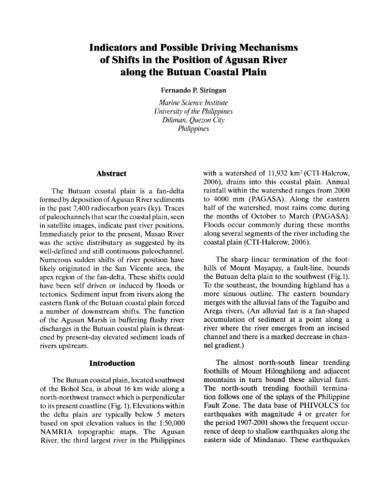Indicators and possible driving mechanisms of shifts in the position of Agusan river along the Butuan coastal plain
- Global styles
- MLA
- Vancouver
- Elsevier - Harvard
- APA
- Help
Share
Abstract
The Butuan coastal plain is a fan-delta formed by deposition of Agusan River sediments in the past 7,400 radiocarbon years (ky). Traces of paleochannels that scar the coastal plain, seen in satellite images, indicate past river positions. Immediately prior to the present, Masao River was the active distributary as suggested by its well-defined and still continuous paleochannel. Numerous sudden shifts of river position have likely originated in the San Vicente area, the apex region of the fan-delta. These shifts could have been self driven or induced by floods or tectonics. Sediment input from rivers along the eastern flank of the Butuan coastal plain forced a number of downstream shifts. The function of the Agusan Marsh in buffering flashy river discharges in the Butuan coastal plain is threatened by present-day elevated sediment loads of rivers upstream.
Suggested Citation
Siringan, F. P. (2008). Indicators and possible driving mechanisms of shifts in the position of Agusan river along the Butuan coastal plain. In J. H. Primavera (Ed.), Proceedings of the 1st Scientific Conference on the Agusan Marsh: Butuan City, Agusan del Norte, Philippines, 21-23 May 2007 (pp. 15-20). UNESCO Jakarta Office, Philippine Council for Aquatic and Marine Research and Development.
Type
Conference paperCollections


